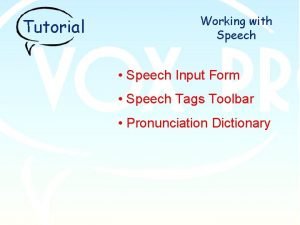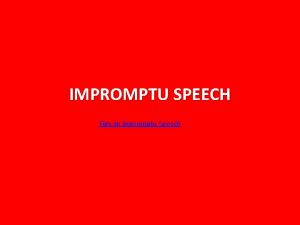Speech to the Young Speech to the ProgressToward










- Slides: 10

Speech to the Young Speech to the Progress-Toward Poem by Gwendolyn Brooks Introducing the Poems Poetic Form: Lyric Poetry Literary Analysis: Sound Devices Reading Skill: Make Inferences

Speech to the Young, Speech to the Progress-Toward / Mother to Son INTRODUCING THE POEMS What is good ADVICE? Suggestions about how to improve your grades or how to approach the new guy at school can be welcome, but how do you know if it’s good advice? Sometimes it depends on who gives it.

Speech to the Young, Speech to the Progress-Toward / Mother to Son INTRODUCING THE POEMS What is good ADVICE? Is it someone who has been there and learned from his or her own experience? Is it someone who cares about you or has a stake in the outcome? In the two poems you are about to read, the speakers share what they have learned with a younger generation.

Speech to the Young, Speech to the Progress-Toward / Mother to Son Poetic Form: Lyric Poetry If you’re a poet and you want to share your deepest feelings on a topic such as love, death, or the power of nature, what kind of poem would you write? A good choice would be a lyric poem. The purpose of a lyric poem is to express personal thoughts and feelings.

Speech to the Young, Speech to the Progress-Toward / Mother to Son Poetic Form: Lyric Poetry To achieve this purpose, lyric poems have the following characteristics. They • are short • have a single speaker who expresses personal thoughts and feelings • focus on a single, strong idea Black Is the Color Black is the color of my true love’s hair. Her lips are like some roses fair. Got the sweetest smile, and the gentlest hands. I love the ground where she stands.

Speech to the Young, Speech to the Progress-Toward / Mother to Son Sound Devices Writers use sound devices to create a musical quality and to call attention to certain words. Alliteration is the repetition of consonant sounds at the beginnings of words. Notice the repeated w sound in the following example: When the wind whispers

Speech to the Young, Speech to the Progress-Toward / Mother to Son Make Inferences As you try to understand the speakers and the advice they give in these two poems, look for clues that hint at their experiences, attitudes, and personality. Combine these clues with your own knowledge or experience to make inferences, logical guesses about what the poet doesn’t state directly.

Speech to the Young, Speech to the Progress-Toward / Mother to Son Make Inferences Use inference equations like the one shown to record your inferences about the speakers. The title of the poem is “Speech to the Young. ” + Older people like to give advice. = Speaker is an older person.

Speech to the Young, Speech to the Progress-Toward / Mother to Son SPEECH TO THE YOUNG, SPEECH TO THE PROGRESS-TOWARD by Gwendolyn Brooks 1 Say to them, say to the down-keepers, 3 the sun-slappers, the self-soilers, the harmony-hushers, 6 "Even if you are not ready for day it cannot always be night. " You will be right. For that is the hard home-run. 9 Live not for battles won. Live not for the-end-of-the-song. Live in the along.

Speech to the Young, Speech to the Progress-Toward / Mother to Son • • • Symbols- Images. Figures of Speech- alliteration Tone. Theme- SIFTT it. . What does Progress-Toward mean? What is a down-keeper (line 2)? What is a sun-slapper (line 3)? What is a self-soiler (line 4)? What is a harmony-husher (line 5)? Explain the meaning of "Even if you are not ready for day it cannot always be night. " • Explain the meaning of line 9: "Live not for battles won". Analyze it. .


















